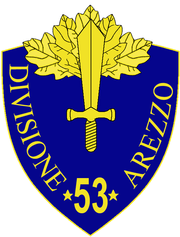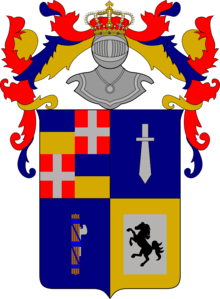53rd Infantry Division Arezzo
The 53rd Infantry Division Arezzo (Italian pronunciation: [aˈrɛttso] ![]()
| 53rd Infantry Division Arezzo | |
|---|---|
 53rd Infantry Division Arezzo Insignia | |
| Active | 1939–1943 |
| Country | Italy |
| Branch | ItalianArmy |
| Type | Infantry |
| Size | Division |
| Nickname(s) | Arezzo |
| Colors | Yellow on left, Blue on right[1] |
| Engagements | World War II |
| Commanders | |
| Notable commanders |
|
History
The Arezzo Division took part in the Italian invasion of Albania in 1939. It was next involved in the Greco-Italian War in November 1940, as part of the Italian XXVI Corps and later Italian XXV Corps. Although it was used initially on Yugoslavian border as part of the 11th army reserve, the division used to oppose a Greek breakthrough at Mal Moravë - Mal Ivan line in Devoll river valley. The Arezzo losses were light until December, 1940.[5] 29 November-3 December 1940 division have suffered a serious losses (the 225th Infantry regiment was decimated) while beating off the Greek assault.[6] The Arezzo division was reformed and sent back to Albania, Korçë, as part of the occupation force within Italian IV Corps. 5 April 1941 it took part in the Invasion of Yugoslavia as part of the Librazhd Sector under command of Italian 9th army.[7] In this role, it captured parts of Montenegro, and used as garrison in Zadar, Ersekë, Korçë and Pogradec. 29 January 1943, the division was reinforced by 343rd infantry regiment.[8] The division remained in the area until the Armistice of Cassibile 8 September 1943. Following the Italian surrender to the Allies in September 1943, the division was disarmed by the Germans. A large number of the men escaped to join the partisans.[9]
Order of battle (1943)

- 225. Arezzo Infantry Regiment
- HQ company
- 3 infantry battalions
- Mortar company (da 81)
- Close support battery (65/17)
- 226. Arezzo Infantry Regiment
- HQ company
- 3 infantry battalions
- Mortar company (da 81)
- Close support battery (65/17)
- 343. Infantry Regiment
- HQ company
- 3 infantry battalions
- Mortar company (da 81)
- Close support battery (47/32)
- 53. Artillery Regiment
- 80. CCNN Legion
- 26. CCNN battalion Legnano
- 67. CCNN battalion Bologna
- 80a Machine gun company
- 53. Mortar Battalion
- 53. Anti-Tank Company
- 53. Engineer Battalion
- 53. Signal Company
- 94. Pioneer Company
- 59. Medical Section
- 60. Supply Section [nb 1][9][11]
Notes
- Footnotes
- An Italian Infantry Division normally consisted of two Infantry Regiments (three Battalions each), an Artillery Regiment, a Mortar Battalion (two companies), an Anti Tank Company, a Blackshirt Legion of two Battalions was sometimes attached. Each Division had only about 7,000 men, The Infantry and Artillery Regiments contained 1,650 men, the Blackshirt Legion 1,200, each company 150 men.[10]
- Citations
- The Italian Army 1940-45 (1): Europe 1940-43 By Philip S. Jowett, p. 38
- Enrico Tagliazucchi and Franco Agostini. "Royal Italian Army". World War II Armed Forces – Orders of Battle and Organizations. Archived from the original on 4 April 2009. Retrieved 4 May 2009.
- http://www.regioesercito.it/reparti/fanteria/rgt/rgt226.htm
- The Arezzo Massacres A TuscanTragedy By Janet Kinrade Dethick, p. 14
- The Defence and Fall of Greece 1940-1941 By John Carr, p. 116
- http://www.regioesercito.it/reparti/fanteria/rgt/rgt225.htm
- The Organization and Order of Battle of Militaries in World War II, By Charles D. Pettibone, p. 119
- http://www.regioesercito.it/reparti/fanteria/rgt/rgt343.htm
- Marcus Wendal. "Italian Army". Axis History. Retrieved 4 May 2009.
- Paoletti, p 170
- "Archived copy" (PDF). Archived from the original (PDF) on 4 March 2016. Retrieved 10 December 2015.CS1 maint: archived copy as title (link)
- Paoletti, Ciro (2008). A Military History of Italy. Greenwood Publishing Group. ISBN 0-275-98505-9.
- Jowett, Phillip. The Italian Army 1040-45 (3): Italy 1943-45. Osprey Publishing, Westminster. ISBN 978-1-85532-866-2.